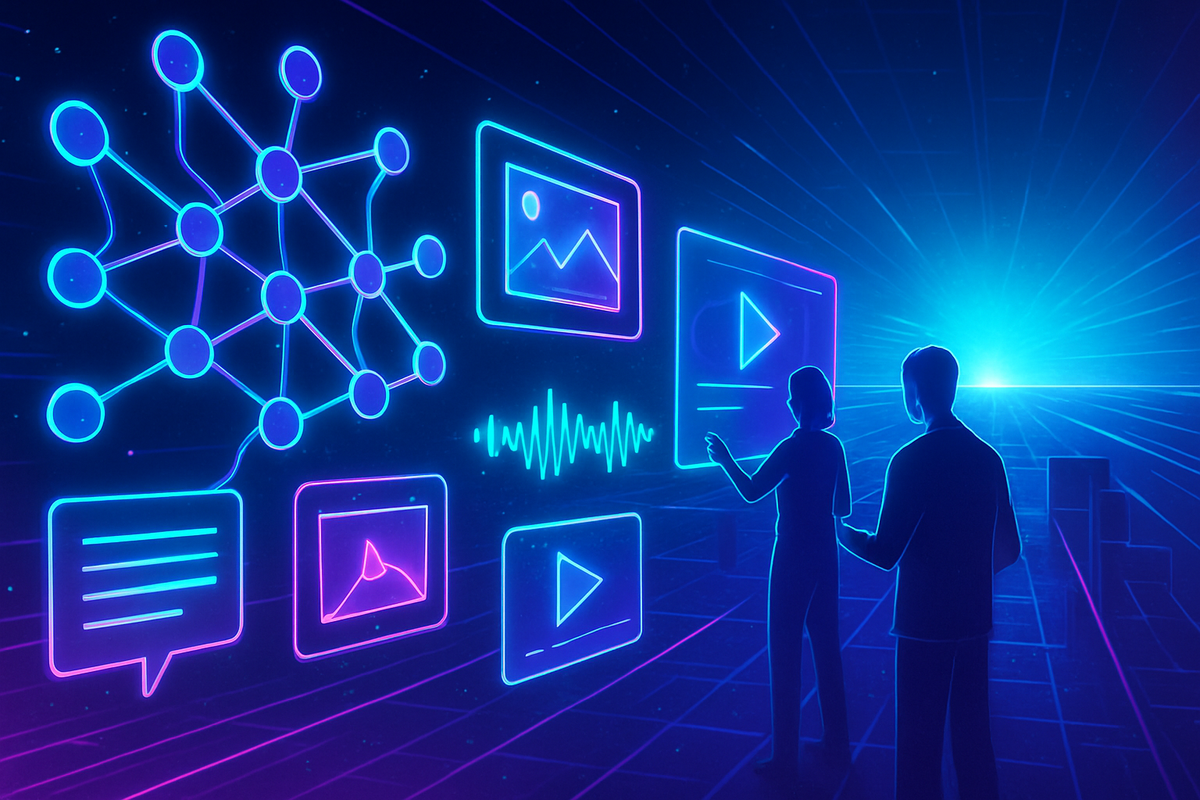
The artificial intelligence landscape is undergoing a profound transformation, marked by the rapid ascent of multimodal AI. This groundbreaking evolution allows AI models to natively process and understand information across diverse data types—text, images, audio, and video—simultaneously, mirroring the holistic way humans perceive the world. This paradigm shift promises to unlock unprecedented capabilities, from more intuitive human-computer interactions to sophisticated real-world problem-solving, fundamentally altering how we interact with technology and the digital realm.
A Unified Intelligence: How Multimodal AI is Redefining AI Capabilities
The current surge in multimodal AI is driven by revolutionary architectural breakthroughs that move beyond integrating separate, specialized AI models. Instead, the focus is on creating unified neural networks capable of end-to-end training across all modalities. This native integration ensures that context and nuanced relationships between different data types are preserved, leading to a more comprehensive understanding. Key advancements include unified neural networks, cross-modal attention layers that align features across modalities, temporal encoders for dynamic data like video and audio, and memory-augmented token streams for enhanced contextual awareness. Early fusion techniques, combining raw input features at the earliest stages of the network, further bolster this integrated approach.
Leading this charge are several pioneering models. OpenAI's (NYSE: MSFT) GPT-4o ("GPT-4 Omni") stands out for its end-to-end training across audio, vision, and text, enabling real-time, low-latency voice conversations with human-like speed and emotional awareness. It can process sampled video frames and generate short videos, alongside its robust text capabilities. Google's (NASDAQ: GOOGL) Gemini 2.0 (and the broader Gemini 2.X series, including Gemini 2.5 Pro and Flash) was built from the ground up to be natively multimodal, seamlessly understanding and combining text, code, audio, image, and video. These models boast impressive long context windows, capable of processing hours of video content and performing complex reasoning over interleaved sequences of various modalities. Building on Gemini 2.5 Pro, Google's Project Astra is a real-time, memory-augmented AI agent designed to see, hear, remember, and reason about the user's environment through live video and audio, achieving sub-300ms response times through a hybrid inference system. While details on a specific "OpenAI Omega model" are less public, general research in this area points towards similar goals of native integration and early fusion for more efficient and comprehensive multimodal understanding. These developments signify a pivotal moment, moving AI from specialized tasks to a more generalized, human-like intelligence.
The Shifting Sands: Winners and Losers in the Multimodal AI Race
The rise of multimodal AI is poised to create significant shifts in the competitive landscape, elevating some companies while challenging others. Big Tech giants like Microsoft (NASDAQ: MSFT), through its substantial investment in OpenAI, and Alphabet (NASDAQ: GOOGL), with its Google DeepMind division leading Gemini and Project Astra, are clear frontrunners. Their vast computational resources, extensive data sets, and deep research capabilities position them to dominate the foundational model space. These companies stand to gain immensely by integrating multimodal AI into their existing product ecosystems, from cloud services (Microsoft Azure, Google Cloud) to consumer applications (Google Assistant, Microsoft Copilot), enhancing user experience and creating new revenue streams.
Beyond the tech behemoths, chip manufacturers like NVIDIA (NASDAQ: NVDA) are undeniable winners. The immense computational demands of training and running multimodal AI models necessitate powerful GPUs and specialized AI accelerators. NVIDIA's CUDA platform and its ecosystem of AI development tools make it indispensable to the entire AI industry, ensuring continued demand for its hardware. Companies specializing in AI infrastructure and data labeling services will also see increased demand, as multimodal models require vast, high-quality, and diverse datasets for training. Conversely, companies reliant on single-modality AI solutions or those with limited R&D budgets may find themselves struggling to keep pace. Startups focused on niche AI applications that can't adapt to a multimodal paradigm might face obsolescence. Furthermore, traditional content creation industries that don't embrace AI-powered tools for generating and analyzing multimodal content could be disrupted, as AI models become capable of producing sophisticated visual, audio, and textual outputs.
Industry Impact and Broader Implications
The advent of natively multimodal AI models represents a seismic shift that will reverberate across numerous industries and societal structures. This event fits perfectly into the broader trend of AI moving from narrow, task-specific applications to more generalized, human-like intelligence. The ability of AI to understand and generate content across text, images, audio, and video simultaneously will lead to unprecedented levels of automation and innovation.
In healthcare, multimodal AI could analyze patient records (text), medical images (X-rays, MRIs), and even audio (patient interviews, heart sounds) to provide more accurate diagnoses and personalized treatment plans. The entertainment and media industries will see revolutionary changes in content creation, from AI-generated films and music to personalized interactive experiences. Education stands to benefit from AI tutors that can understand visual learning materials, spoken questions, and written assignments, adapting to diverse learning styles. Potential ripple effects include increased competition among AI developers, pushing the boundaries of what's possible, and fostering new partnerships between AI companies and industry-specific enterprises. Regulatory bodies will face the complex challenge of developing frameworks for AI ethics, bias detection, and intellectual property rights in a world where AI can generate highly realistic and complex multimodal content. Historically, this mirrors the impact of the internet's rise, which similarly integrated various forms of media, but with AI, the integration is not just about access but about understanding and creation.
What Comes Next: The Future Unfolds
In the short term, we can expect a rapid proliferation of multimodal AI capabilities integrated into existing consumer and enterprise applications. Virtual assistants will become far more sophisticated, capable of understanding complex commands involving visual cues or emotional tones in speech. Customer service will be revolutionized by AI agents that can not only understand spoken queries but also analyze visual information from a user's screen or camera to provide real-time, context-aware support. For businesses, this means enhanced analytics, more dynamic marketing campaigns, and more efficient content creation pipelines.
Long-term possibilities are even more transformative. We could see the emergence of truly "agentic" AI systems that can autonomously navigate and interact with the physical world, performing complex tasks by combining perception, reasoning, and action across modalities. This opens up market opportunities in robotics, smart infrastructure, and personalized assistive technologies. However, challenges will also emerge, including the need for robust safety mechanisms to prevent misuse, the development of explainable AI to ensure transparency, and addressing the societal impact on employment as AI takes on more complex roles. Strategic pivots will be required for companies to adapt, focusing on how to leverage these new capabilities to create unique value propositions. Investors should watch for companies that are not only developing foundational multimodal models but also those effectively integrating these models into vertical-specific solutions, demonstrating clear pathways to commercialization and ethical deployment.
Conclusion: A New Era of Intelligent Interaction
The rise of multimodal AI marks a pivotal moment in the history of artificial intelligence, moving us beyond specialized, siloed AI systems towards a more unified and human-like understanding of the world. The architectural breakthroughs enabling models like OpenAI's GPT-4o and Google's Gemini 2.0 and Project Astra to natively handle text, images, audio, and video simultaneously are not merely incremental improvements; they represent a fundamental shift in how AI perceives, processes, and interacts with information. This integrated approach promises to unlock unprecedented levels of contextual understanding, real-time problem-solving, and natural human-AI interaction.
Moving forward, the market will be defined by the ability of companies to harness these multimodal capabilities to create innovative products and services. Investors should closely monitor the continued advancements in foundational models, the development of specialized applications leveraging multimodal AI, and the evolving regulatory landscape. The lasting impact of this technological revolution will be profound, ushering in an era where AI is not just a tool but a truly intelligent and perceptive partner, fundamentally reshaping industries, enhancing human capabilities, and redefining the boundaries of what is possible in the digital age. The journey has just begun, and the coming months will undoubtedly reveal further exciting developments in this rapidly evolving field.






